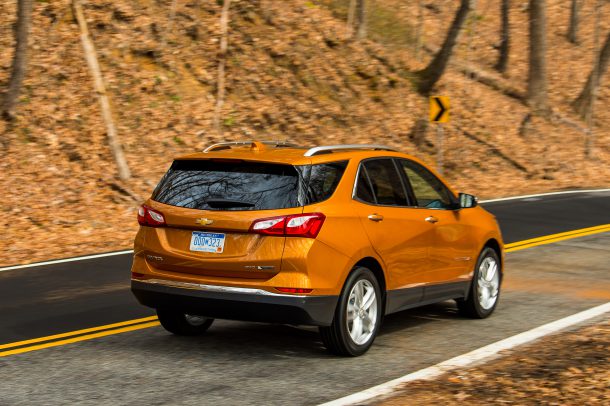Finding More Power for Your Chevrolet Equinox Means Waiting a Little Longer

General Motors will happily let you configure a newly downsized 2018 Chevrolet Equinox, but moving up a step in power means cooling your heels for a few more months.
The third-generation crossover bowed this spring with a turbocharged 1.5-liter four-cylinder as its base powerplant, mated to a six-speed automatic transmission and front- or all-wheel-drive traction. While that mill generates 170 horsepower and 203 lb-ft of torque, more power is on the way.
Chevrolet plans to offer two engine upgrades for the slimmed-down Equinox — a turbocharged 2.0-liter four and a 1.6-liter diesel. The first of those two engines gained its emissions certification from the California Air Resources Board last week.
While not yet available on GM’s online Build & Price tool, a spokesperson for the automaker tells us the engine should appear on the configurator about the same time the uplevel Equinox hits dealer lots. When asked when that would be, Chevrolet assistant communications manager Tara Kuhnen could only say in the “summer timeframe.”
Moving up to the 2.0-liter brings 252 hp and 260 lb-ft to the table, as well as a nine-speed automatic. The automaker estimates a 29 mile-per-gallon highway fuel economy rating — 3 mpg less than the base front-drive 1.5-liter model.
Diesel models stand to see 137 hp and 240 lb-ft, plus a significant fuel economy boost. Though the Environmental Protection Agency has yet to bestow a fuel economy rating on the 1.6-liter Equinox, or the 2.0-liter for that matter, the same oil-burner allows GM to advertise a 52 mpg highway rating for its diesel Cruze. However, that model only reaches the sky-high rating via a six-speed manual transmission. When equipped with a nine-speed automatic, the highway figure lowers to 47 mpg, though the 37 mpg combined rating remains the same.
[Image: General Motors]

More by Steph Willems
Latest Car Reviews
Read moreLatest Product Reviews
Read moreRecent Comments
- Michael I don’t have the luxury of choosing the color of my car and even people in my life who have recently purchased relatively expensive new cars are having their choice of what local dealers have or what they’re getting in soon, shades of grey and white. If I had the choice I would have gone with color when I was younger but now would choose a silver, grey, or black. Whatever looked best on the model.
- CoastieLenn That price seems a bit high for a high mileage mid-tier Accord, especially a coupe whose resale is typically lower than the stalwart sedan. I do like this generation coupe a lot though.
- La3541 Red is my go-to color. I love candy-apple red (guards red on Porsche). I have had several red cars. Maroon is not good though.I have always loved British racing green and recently got my first one. A British racing green 4-series that I had to special-order.Silver, black, gray, and white are pretty boring. However, as RNA656.. stated, white looks good on some cars. for more boring colors, I also like chalk on porsches. Nardo gray on Audis is pretty nice.
- CoastieLenn They're gonna sell tens of these, and I don't believe those presented numbers for a second! Good on them for offering it though.
- Chris P Bacon Tuscadero is pink, but eye-searingly is a bit of a stretch. It's actually a little on the darker side in person. Jeep dropped the color just before we could order our '22 4xe. So we got one in High Velocity yellow. Sahara, with a soft top. Was the first one that made it to the dealer when it was delivered, salesman told us everyone in the showroom went out to see it when the truck rolled in. The missus loves it. It's not a color you could put on anything, but it works on the Jeep.



































Comments
Join the conversation
The base engine needs about 10 -15 more horses and make the 9 speed an option for maximum mileage potential for the gas mills.
What is the cost basis rationale of offering both a 1.5 turbo four AND a 2.0 turbo four? The raw material costs between the two have to cost virtually the same to build. Both have turbo, four coilpacks, four pistons, etc. By having two drivetrains, the engineering and calibration and certification costs are absurdly higher. Does the 1.5 exist solely for EPA manipulation? Because it can't be more profitable than just equipping all of them with 2.0T's, especially considering the elimination of options. It further seems redundant when they're offering the mileage juggernaut option in the form of the 1.6 diesel as well.